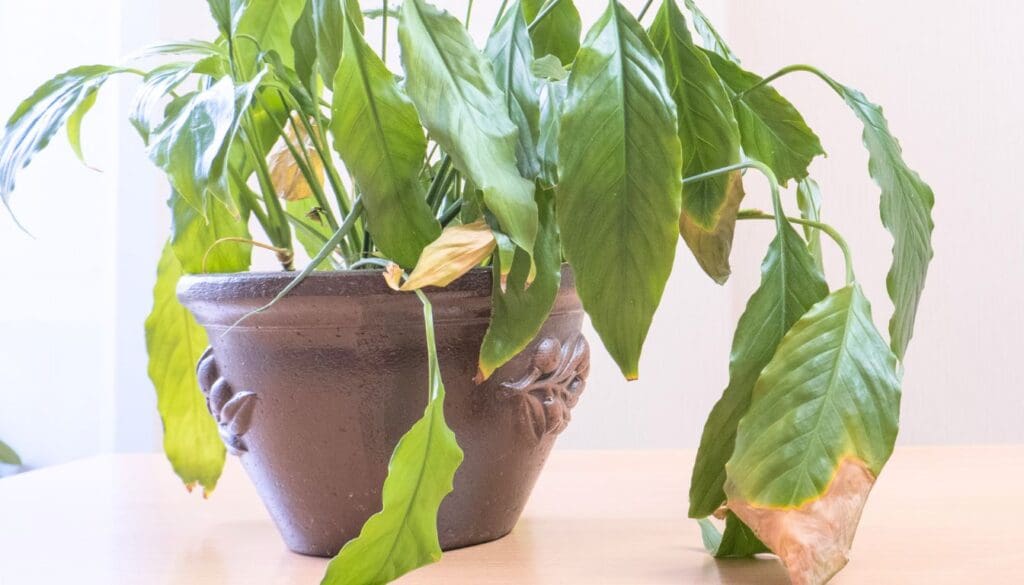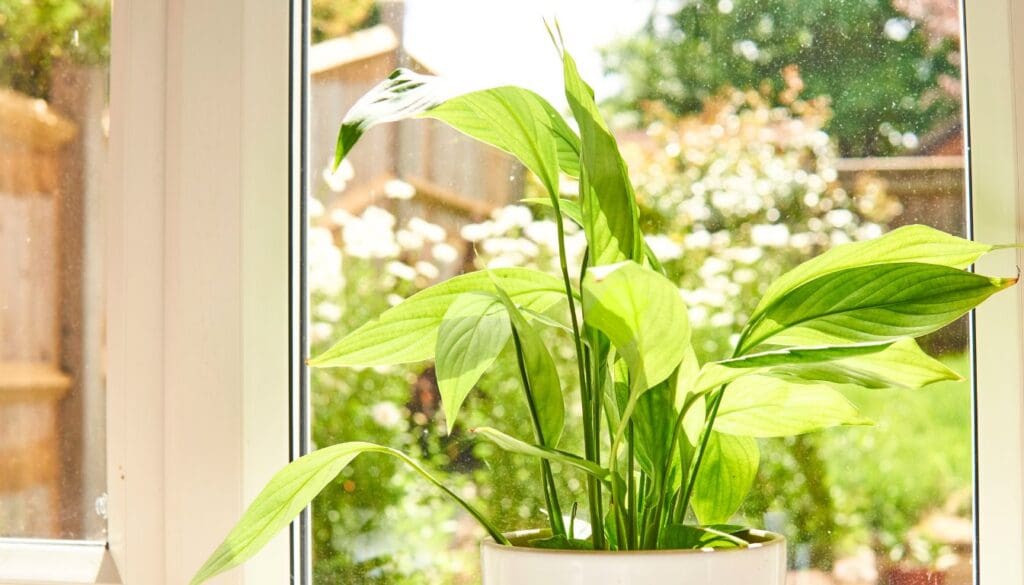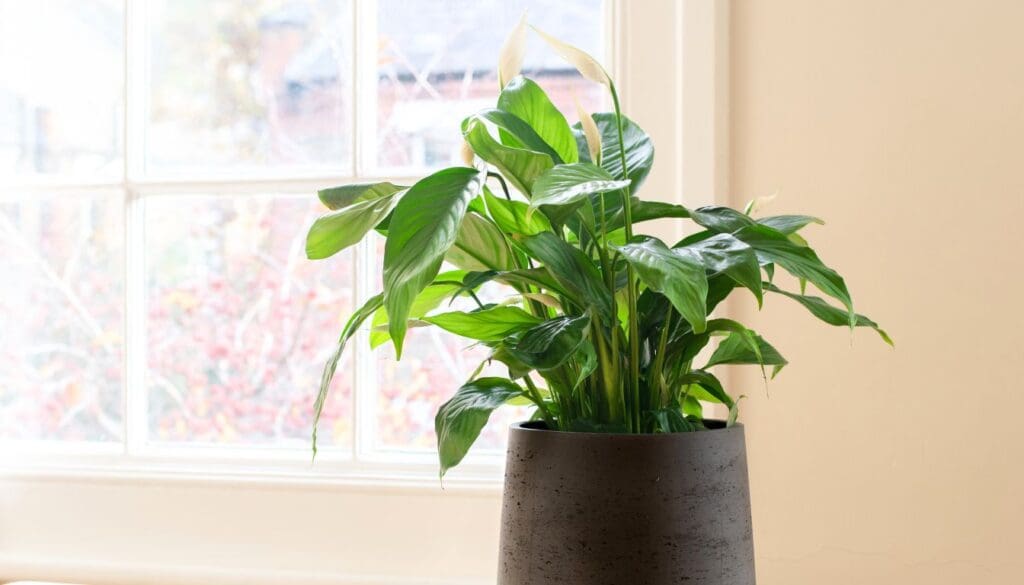How To Fix A Sunburned Peace Lily? (Causes+Tips)
Peace lilies are low-maintenance popular indoor plants. These plants prefer indirect light and can flower even in low light conditions. If someday you decide to move your plant outside for extra sun, you might find that your peace lily has got sunburned.
So, in this article, we shall learn why do peace lilies get sunburned and how to fix a sunburned peace lily.
Exposure to the direct sun can damage the foliage and lead to sunburn in peace lilies. To protect your peace lily from sunburn, move your plant to a spot where it will get bright indirect light. In case of sunburn, hydrate the plant and increase the humidity to help the plant recover quickly.
Provide your peace lily adequate water, nutrition and maintain optimal temperatures and humidity.
In this article, we will discuss the results of direct sunlight on your peace lily. This article will also help you with ways to save your peace lily from sunburn.

Please note: Simplify Plants is reader-supported. Some links in the post are affiliate links and I get a commission from purchases made through links in the post.
How do you know if your peace lily is sunburnt?
Sunburn on peace lily occurs when it is exposed to direct sunlight. The first sign is the discoloration of leaves which appears on the topmost leaves of the peace lily plant.
In sunburn, the outer layer of leaf tissues burns up, causing discoloration on the top leaves or the ones most exposed to the sunlight.
Signs of sunburn in peace lily include curling of leaves, brown edges on leaves, dead-looking spots on leaves. Sometimes, mild exposure to the sun causes some of the leaves to turn yellow or give them a washed-out white appearance.
The leaves closer to the soil will get some shade from the higher leaves, and the color will not change. And if you find the all the leaves are affected, then it’s maybe sunburn.
What can cause sunburn on peace lily?
Sunburn on peace lily is a severe problem that can have long-lasting effects on a peace lily, sometimes fatal.
So understanding its cause is essential to deal with this problem. Let’s discuss the causes of sunburn on the peace lily.
Direct sunlight

Peace lilies are indoor plants that prefer dappled or indirect sunlight. Moving your plant to a sunny spot will cause sunburn.
Exposure to direct sunlight will damage the leaves and flowers of your plant. The bright sunlight will reduce the chlorophyll in leaves, leading to discoloration.
Direct sunlight will shock the plant and will make it brittle, dry, droopy, and scorched. So always keep your plant away from direct sunlight to save them.
High temperatures
Peace lily needs an ideal room temperature for growth. If you are exposing them to direct sunlight, it will increase the temperature of the plant.
Generally, the room temperature in which peace lily live comfortably is 65-75°F.
But a temperature above 85°F will be unbearable for the plant, and they will experience different problems because of too much heat exposure.
The leaves will wilt as water drains out from the leaves, making them dry. Heat waves will cause fewer flowers.
The leaf pores (stomata) close up, and the plants find it difficult to breathe in higher temperatures, which also weakens their immune system.
Low humidity

Peace lily likes humidity. Direct sunlight will lower the humidity level and make the soil dry and create drought stress in plants.
Low humidity leads to brown tips of the leaves and causes the plant to stop blooming.
To increase humidity, place your plants on a tray of pebbles to retain moisture, mist their leaves, and place a humidifier.
How to prevent sunburn in peace lily?
Prevention is better than cure, so you can prevent sunburn by taking appropriate steps to protect your peace lily from direct sunlight.
Since peace lily needs indirect sunlight, position them in a place that suits their light needs and protects them from harsh sunlight and winds.
If you have placed your peace lily on a window or in a location where it gets direct sunlight, it will get sunburnt. Start moving your plant to a shady spot where it will get indirect light but no direct sunlight.
You can place your peace lily a few inches away from the window to protect it from direct light. You can also filter the light by adding a sheer curtain to the window. In this way, the plant will get bright sunlight but won’t get exposed to the direct sun.
When moving your peace lily outdoors in the summer, place it under the shade of a tree or a structure to protect it from hot direct sun rays that can burn its leaves.
Sometimes heat gets combined with dry winds, which can be lethal to your plant. So always water your plant on scorching days.
Opt for morning watering. Morning watering will prevent the water from evaporating quickly and give the plant adequate time to absorb moisture.
Mist the leaves of your plant often. You can mulch the soil to keep the soil moist, which leaves the plant less exposed to sunburn.
What to do if my peace lily is sunburnt?
If your peace lily is already sunburnt, that means you have to take action immediately. The longer you keep your peace lily vulnerable to these stresses, the less likely it will get back to everyday life.
So without wasting time, immediately move your plant to a shadier spot away from direct sunlight. It will reduce the damage of the leaf cells and prevent the breakdown of chlorophyll.
Providing your peace lily bright indirect light will ensure that it has enough energy to produce flowers and prevent sunburn. Don’t trim off the damaged parts of the plant, as this will support the plants while it recovers.
Remove those leaves that are completely dead and brown. Cut the shoots of plants right at the soil level with scissors.
Then water your peace lily weekly as the plant is already dehydrated. Try maintaining slightly moist soil to retain moisture.
Mist the leaves of your plants to increase the humidity for them. You can also mulch around the soil as it will help water retention and maintain moisture levels.
You must stop fertilizing your peace lily until it shows some signs of recovery and new leaves come out.
The individual damaged leaves will not get recovered but won’t harm the plant anymore. Once the new leaves come out, prune off the dead and damaged leaves.
Peace lily may take a longer time to recover as they are slow growers. So don’t get stressed, have patience and take proper care.
Tips for a healthy peace lily
Some care tips that will help your peace lily grow well and bloom more are:

Light
- Peace lily prefers bright indirect sunlight. They can tolerate low light conditions but can’t tolerate direct sunlight. So keep them away from the direct rays of the sun.
- You should place your peace lily in a location that provides indirect sunlight, like a window where it will get a sufficient amount of indirect light throughout the day.
- If the window does not support indirect light, cover the window with curtains to filter direct sunlight.
- You can even use artificial sources of light to fulfill your peace lily’s lighting requirements.
Also read: What Kind Of Light Does A Peace Lily Need? (Peace Lily Light Requirements)
Water
- You should maintain consistency while watering your peace lily. Maintain moist soil but avoid overwatering as it can cause root rot issues in the plant.
- Sometimes the plant will droop a bit when thirsty, indicating that it needs to drink water. So immediately provide water to them. They will tolerate short periods of dry soil, but their leaves will turn brown if you fail to understand their water requirements.
- Always check the soil’s moisture level before watering and use a well-draining pot to drain excess water.
- Water your peace lily once a week and sprinkle their leaves with water throughout the summer to help them stay hydrated.
Also read: How Often Should A Peace Lily Be Watered? (Peace Lily Water Requirements)
Temperature
- Peace lily makes an excellent indoor plant because it thrives well in indoor temperatures. So keep it in temperatures between 60-70 °F.
- Peace lily cannot tolerate cold temperate below 45°F. So don’t place them by a door that opens to cold air and keep the plant away from cold, drafty windows.
- Keep your peace lily away from any heating and cooling appliances.
Also read: Where Should Peace Lily Be Placed? (Ideal Spot+Placement Tips)
Humidity

- Peace lily enjoys a high amount of humidity. They need at least 50% humidity to stay healthy.
- Low humidity can cause sunburn and other issues. So mist their leaves and place them on a tray of moistened gravel to increase humidity around the plant.
- You can place them near a humidifier to increase humidity for them.
Also read: Do Peace Lilies Need Misting? (+Ideal Humidity)
Fertilization
- Use organic fertilizers in the spring and summer seasons to help your plant flower. Fertilize them every six weeks in spring and summer for growth.
- Peace lilies are sensitive to chemical fertilizers, so try to use organic fertilizers on them.
Also read: What Kind Of Fertilizer Does A Peace Lily Need? (Peace Lily Fertilizer Ratio)
Drainage
- Peace lilies are susceptible to root rot diseases. So make sure that the soil gets a chance to dry out between waterings.
- Plant your peace lily in a pot with lots of drainage holes and place a saucer below the pot to catch the water that drains out.
Also read: What Kind Of Soil To Use For Peace Lily? (Peace Lily Soil Mix)
Final words
To keep your peace lily away from sunburn, you should keep it away from direct sunlight. Keep your peace lily in a spot where it gets an ample amount of bright indirect light.
Peace lilies can tolerate low light but not direct sunlight. The leaves and parts that get scorched due to direct sunlight do not become healthy again, so you must try to keep your peace lily protected from the harsh direct sunlight.
Take proper care of your peace lily by ensuring it gets the right amount of light, water, humidity, temperature, fertilizer, and drainage.
Ref: ScienceDirect, NCBI, University of Vermont, Nationalgeographic, NC state university, University of Florida, The University of Arkansas, Queensland Government.
Recommended Garden Supplies
| Product Image | Our Recommended Gardening Supplies | Check Offers! |
|---|---|---|
Top Top
Top
Top
Top
Top
Top
Top
Top | rePotme Houseplant and Tropical Classic Potting Soil Mix | Check Offer On Amazon |
 Top
Top
Top
Top
Top
Top
Top
Top | Espoma Organic Indoor Plant Food | Check Offer On Amazon |
 Top
Top
Top
Top
Top
Top
Top
Top | GooingTop LED Grow Light 6000K Full Spectrum Clip Plant Growing Lamp | Check Offer On Amazon |
 Top
Top
Top
Top
Top
Top
Top
Top | Soil Moisture Meter | Check Offer On Amazon |
 Top
Top
Top
Top
Top
Top
Top
Top | Govee Hygrometer Thermometer, Bluetooth Enabled! | Check Offer On Amazon |
 Top
Top | LEVOIT Humidifiers for Large Room(Best For Plants) | Check Offer On Amazon |
 Top
Top
Top
Top
Top
Top
Top
Top | Upgraded DIY Automatic Drip Irrigation Kit, 15 Potted Houseplants Support | Check Offer On Amazon |
 Top
Top
Top
Top
Top
Top
Top
Top | Stainless Steel Heavy Duty Gardening Tool Set | Check Offer On Amazon |
 Top
Top
Top
Top
Top
Top
Top
Top | Bonide Insecticidal Soap | Check Offer On Amazon |
 Top
Top
Top
Top
Top
Top
Top
Top | Bonide 32 oz Spray Neem Oil for Organic Gardening | Check Offer On Amazon |
 Top
Top
Top
Top
Top
Top
Top
Top | Garden Safe Fungicide | Check Offer On Amazon |






